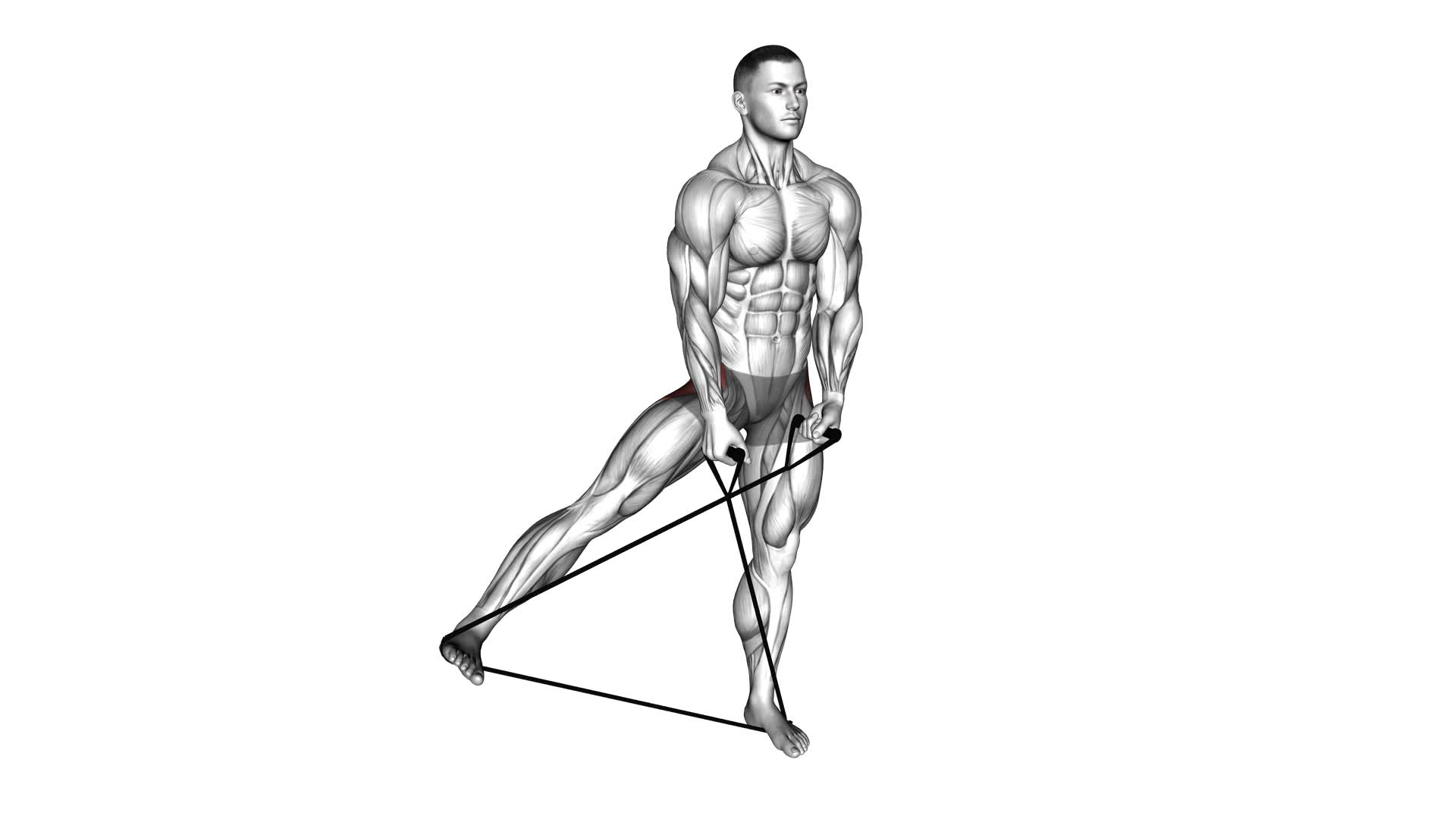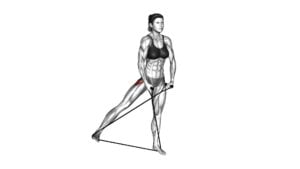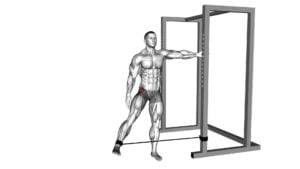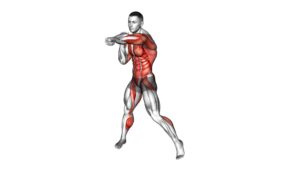Band Cross Abduction – Video Exercise Guide & Tips

Are you looking for a new exercise to target your glutes and outer thighs? Look no further than band cross abduction.
Watch This Exercise Video
In this video exercise guide, we'll show you how to properly perform this exercise using a resistance band.
You'll learn the benefits, proper equipment and set-up, step-by-step instructions, common mistakes to avoid, variations and progressions, and tips for maximizing your results.
Get ready to feel the burn and tone those muscles with this effective exercise. Let's get started!
Key Takeaways
- Band Cross Abduction targets hip muscles and increases stability in the hip joint.
- It adds an extra level of challenge to your workout.
- The exercise targets gluteus medius and minimus muscles for hip stabilization and abduction.
- Band Cross Abduction improves overall hip stability and reduces the risk of injury.
Benefits of Band Cross Abduction
The benefits of band cross abduction are numerous and can greatly enhance your workout routine. This exercise targets the hip muscles and helps to increase stability in the hip joint. By using a resistance band, you can add an extra level of challenge to your workout and maximize muscle activation.
Band cross abduction specifically targets the gluteus medius and minimus muscles, which are responsible for hip stabilization and abduction. These muscles play a crucial role in maintaining proper alignment and balance during movement. By strengthening these muscles, you can improve your overall hip stability and reduce the risk of injury.
In addition to increased hip stability, band cross abduction also enhances glute activation. The glutes are the largest muscle group in the body and are responsible for hip extension and rotation. By engaging them in this exercise, you can improve their strength and power, leading to better overall performance in activities such as running, jumping, and lifting.
Now that you understand the benefits of band cross abduction, it's important to focus on proper equipment and set-up to ensure you get the most out of this exercise.
Proper Equipment and Set-Up
To ensure you get the most out of the band cross abduction exercise, it's important to have the proper equipment and set-up. One key aspect is the band tension. The band you use should provide enough resistance to challenge your muscles but not be too difficult to perform the exercise with proper form. It's recommended to start with a lighter band and gradually increase the tension as you become stronger. This will help prevent injuries and allow for proper muscle development.
Another important factor is the resistance level. Different bands have different levels of resistance, usually indicated by color or intensity. It's crucial to choose a band with an appropriate resistance level for your fitness level and goals. If the band is too easy, you won't see significant results. On the other hand, if the band is too difficult, you may struggle to complete the exercise correctly and risk injury. Finding the right balance is key.
In terms of set-up, make sure the band is securely anchored to a stable object. This could be a door, a pole, or a wall anchor specifically designed for resistance bands. Ensure that the anchor point is at chest height or slightly lower, allowing you to perform the exercise comfortably and with proper alignment. Double-check the anchoring system before starting the exercise to avoid any accidents or interruptions during your workout.
Step-by-Step Guide to Performing the Exercise
To perform the Band Cross Abduction exercise with proper form, there are a few key tips to keep in mind.
First, make sure to keep your core engaged and your back straight throughout the movement.
Secondly, avoid swinging your legs or using momentum to lift the band.
Lastly, be mindful of your foot placement and aim to keep your knees in line with your toes to prevent any strain on the joints.
Proper Form Tips
To perform the Band Cross Abduction exercise with proper form, start by securing a resistance band around your ankles. This will provide the necessary resistance to engage your hip abductors effectively. Here are some tips to ensure correct form and prevent injuries:
- Stand with your feet shoulder-width apart and knees slightly bent.
- Keep your core engaged and maintain a tall posture throughout the exercise.
- Take a step to the side with one foot, keeping the resistance band taut.
- Slowly cross your other foot over, maintaining tension in the band.
- Return to the starting position by stepping back with the crossed foot.
- Repeat the movement on the opposite side.
Common Mistakes to Avoid
Now let's go over some common mistakes to avoid when performing the Band Cross Abduction exercise.
To ensure you get the most out of this exercise and prevent any potential injuries, it's important to be aware of these errors and how to avoid them.
Firstly, one common mistake isn't using the proper resistance band. Make sure to choose a band that provides enough tension to challenge your muscles without causing strain.
Secondly, avoid letting your hips rotate or twist during the movement. Keep your core engaged and maintain a stable position throughout.
Lastly, be mindful of your form and avoid rushing through the exercise. Focus on controlled movements and maintain proper alignment.
Common Mistakes to Avoid
To ensure proper form during the band cross abduction exercise, it's important to be aware of some common mistakes to avoid.
First, make sure to maintain proper alignment by keeping your core engaged and your spine neutral.
Secondly, be cautious of using too much resistance or tension in the band, as this can lead to strain or injury.
Lastly, always use the appropriate equipment, such as a resistance band with handles, to ensure a safe and effective workout.
Form Correction Tips
Correct your form when performing the Band Cross Abduction exercise by focusing on proper alignment and engaging the targeted muscles. Here are some form correction tips to help you avoid common mistakes and get the most out of your workout:
- Keep your back straight and core engaged throughout the exercise.
- Avoid arching your back or rounding your shoulders.
- Maintain a slight bend in your knees and avoid locking them.
- Make sure to use controlled and deliberate movements, rather than swinging your legs.
To get the best results from the Band Cross Abduction exercise, it's recommended to perform it as part of a well-rounded strength training routine. You can incorporate it into your leg day workout or as a dynamic warm-up before a lower body workout. Remember to start with a lighter resistance band and gradually increase the intensity as you get stronger.
Injury Prevention Techniques
How can you prevent injuries and avoid common mistakes when performing the Band Cross Abduction exercise?
Injury prevention is crucial when engaging in any form of physical activity. To prevent injuries during the Band Cross Abduction exercise, it's essential to start with a proper warm-up routine. Warm-up exercises such as jogging, jumping jacks, or dynamic stretches help increase blood flow to the muscles, improve flexibility, and reduce the risk of muscle strains or tears.
Additionally, it's important to use the correct form and technique during the exercise. Ensure that you maintain proper alignment, engage your core muscles, and avoid excessive or jerky movements. Gradually increase the intensity and resistance of the exercise to avoid overloading the muscles and joints.
Proper Equipment Usage
Use the proper equipment when performing the Band Cross Abduction exercise to avoid common mistakes and maximize your workout. Proper equipment usage is crucial for injury prevention and ensuring the effectiveness of your exercise routine.
Here are some common mistakes to avoid when using equipment for the Band Cross Abduction exercise:
- Not checking the equipment for damage: Before using any resistance bands or other equipment, inspect them for any signs of wear and tear. This will help prevent accidents and injuries during your workout.
- Using the wrong resistance level: Select a resistance band that provides enough challenge without compromising your form. Using a band that's too light or too heavy can lead to poor technique and potential strain or injury.
- Improper band placement: Place the band securely around your ankles, ensuring it's snug but not too tight. This will help target the correct muscles and avoid unnecessary strain on other areas.
- Neglecting equipment maintenance: Regularly clean and maintain your resistance bands to ensure their longevity and effectiveness. This includes wiping them down after each use, storing them properly, and replacing any worn-out bands.
Variations and Progressions
Try incorporating different variations and progressions into your band cross abduction exercise routine for added challenge and effectiveness.
To take your workout to the next level, you can try advanced variations of the band cross abduction. One option is to increase the resistance of the band by using a thicker band or adding more bands. This will make your muscles work harder and promote strength gains.
Another advanced variation is to perform the exercise on an unstable surface, such as a balance board or a Bosu ball. This will engage your core muscles even more and improve your overall stability.
If you're looking for modification options, you can start by using a lighter resistance band or decreasing the range of motion. This will allow you to focus on proper form and gradually build strength.
Another modification option is to perform the exercise in a seated position, which can be helpful if you have difficulty balancing or have limitations in your lower body.
Incorporating variations and progressions into your band cross abduction routine won't only keep your workouts interesting, but also challenge your muscles in different ways. This will help prevent plateaus and ensure continuous progress.
Now that you know how to vary your band cross abduction exercise, let's move on to some tips for maximizing your results.
Tips for Maximizing Results
To maximize your results, focus on engaging your muscles fully throughout the band cross abduction exercise. Here are some tips to help you get the most out of your workout:
- Maintain proper form: Make sure your body is aligned correctly and your movements are controlled. This will help target the muscles you want to work on and prevent injuries.
- Use the right resistance: Choose a band that provides enough tension to challenge your muscles without compromising your form. Gradually increase the resistance as you get stronger.
- Vary your workout: Incorporate different exercises and variations into your routine to prevent plateaus and keep your muscles guessing. This will help you continue to make progress and avoid boredom.
- Listen to your body: Pay attention to how your muscles feel during the exercise. If you experience pain or discomfort, adjust your form or reduce the resistance. It's important to challenge yourself, but not at the expense of your well-being.
Common misconceptions about effective workout routines include the belief that more is always better and that focusing on one muscle group exclusively will yield faster results. In reality, giving your body time to rest and recover is just as important as the exercise itself. Remember to incorporate rest days into your routine and prioritize overall muscle balance for optimal results.
Frequently Asked Questions
Can I Perform Band Cross Abduction Without Using Resistance Bands?
Yes, you can perform band cross abduction without using resistance bands. There are alternative exercises you can try, such as using a cable machine or dumbbells.
However, it's important to note that resistance bands offer unique benefits. They provide constant tension throughout the movement, helping to strengthen and tone your muscles effectively.
If you don't have access to resistance bands, try incorporating other exercises that target the same muscle groups for a similar effect.
How Many Times a Week Should I Incorporate Band Cross Abduction Into My Workout Routine?
To maximize the benefits of band cross abduction and see results, it's recommended to incorporate this exercise into your routine at least 2-3 times a week. This will help target your glutes, hips, and thighs effectively.
Remember to start with lighter resistance bands and gradually increase the intensity as you become more comfortable.
There are also variations of band cross abduction that you can try to keep your workouts challenging and engaging.
Can Band Cross Abduction Help With Improving My Balance and Stability?
Band cross abduction is an effective exercise for improving your balance and stability. By engaging your core muscles and increasing hip mobility, this exercise helps you maintain a stable and aligned body position.
The band resistance adds an extra challenge, forcing your muscles to work harder and enhancing your overall stability.
Incorporating band cross abduction into your workout routine a few times a week can greatly improve your balance and stability.
Are There Any Modifications for Individuals With Knee or Hip Injuries?
If you have knee or hip injuries, there are modifications you can make to the Band Cross Abduction exercise.
For knee injuries, you can try using a lighter resistance band or reducing the range of motion.
For hip injuries, you can try doing the exercise while lying on your side instead of standing.
These modifications will help protect your injured joints while still allowing you to work on your balance and stability.
Can Band Cross Abduction Help With Reducing Lower Back Pain?
Band cross abduction can be a helpful exercise for reducing lower back pain. By targeting the muscles in your hips and glutes, this technique can strengthen your core and improve your posture, which can alleviate stress on your lower back.
The benefits of band cross abduction include increased stability, improved balance, and reduced risk of injury.
To perform this exercise, you'll need a resistance band and follow a specific technique that targets the desired muscles.
Conclusion
In conclusion, band cross abduction is a highly effective exercise that targets the outer hip muscles and helps improve hip stability and strength. By using a resistance band, you can add extra resistance and challenge to the exercise.
It's important to set up the equipment properly and follow the step-by-step guide to perform the exercise correctly. Avoid common mistakes and try different variations to keep challenging your muscles.
Remember to maximize your results by staying consistent and gradually progressing in intensity.

Author
Years ago, the spark of my life’s passion ignited in my mind the moment I stepped into the local gym for the first time. The inaugural bead of perspiration, the initial endeavor, the very first surge of endorphins, and a sense of pride that washed over me post-workout marked the beginning of my deep-seated interest in strength sports, fitness, and sports nutrition. This very curiosity blossomed rapidly into a profound fascination, propelling me to earn a Master’s degree in Physical Education from the Academy of Physical Education in Krakow, followed by a Sports Manager diploma from the Jagiellonian University. My journey of growth led me to gain more specialized qualifications, such as being a certified personal trainer with a focus on sports dietetics, a lifeguard, and an instructor for wellness and corrective gymnastics. Theoretical knowledge paired seamlessly with practical experience, reinforcing my belief that the transformation of individuals under my guidance was also a reflection of my personal growth. This belief holds true even today. Each day, I strive to push the boundaries and explore new realms. These realms gently elevate me to greater heights. The unique combination of passion for my field and the continuous quest for growth fuels my drive to break new ground.







